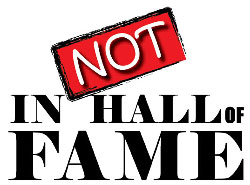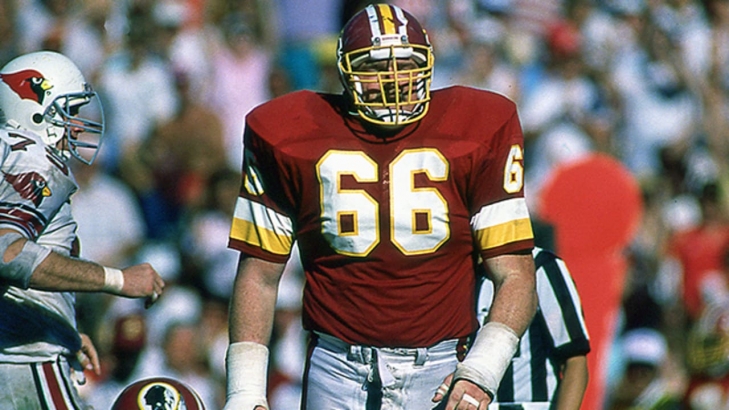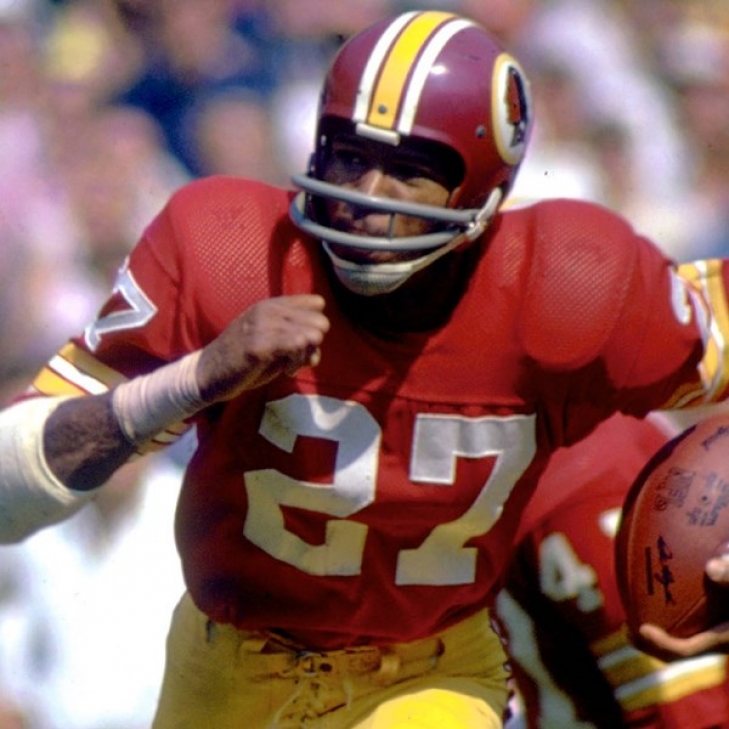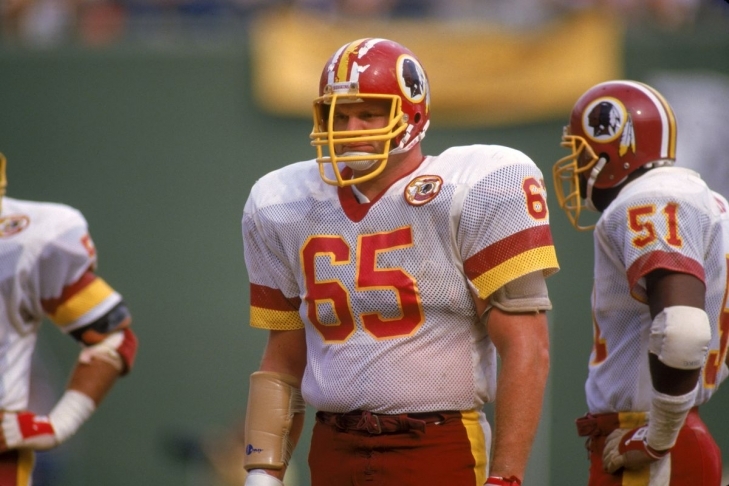13. Trent Williams
The first Offensive Lineman chosen in the 2010 NFL Draft was Trent Williams of Oklahoma, whom the Washington Redskins selected with the Fourth Overall Pick. As gridiron history would show, it was an excellent choice.
12. Joe Jacoby
Joe Jacoby went undrafted in 1981, but he found employment with the Washington Redskins where he would become one of the greatest undrafted players in franchise history.
11. Joe Theismann
The Miami Dolphins drafted Joe Theismann in 1971, but he never signed with them, instead electing to go north to the Canadian Football League with the Toronto Argonauts, where he was a two-time CFL All-Star. The Dolphins would trade the Quarterback's rights in 1974 to the Washington Redskins, where he would sign as Billy Kilmer's backup.
8. Larry Brown
Larry Brown was considered an underachiever at Kansas State, which explains why he dropped to the Eighth Round in the 1969 Draft despite his immense talent. The Washington Redskins were the team that took him, and new Head Coach, Vince Lombardi had a special project on his hands.
6. Sonny Jurgensen
Drafted by the Philadelphia Eagles in 1957, Sonny Jurgensen was the Eagles’ backup when they won the 1960 NFL Championship. Jurgensen took over after as their starting QB, leading the league in Passing Yards in both 1961 and 1962. Jurgensen was hurt for much of 1963, and the Eagles deemed him expendable, and he was traded to the Washington Redskins for fellow QB, Norm Snead, and Cornerback, Claude Crabb.
5. Art Monk
Art Monk showed a lot of promise at the University of Syracuse, so much so that he was a First Round Pick (18thOverall) in the 1980 Draft.
10. Russ Grimm
The Washington Redskins won three Super Bowls within the 1980s and early 90s, but unlike most great teams, the Offensive Line was considered the star attraction. They were the elite group that did not just win three Super Bowls but protected three different ones to a title. This group were the "Hogs," and the best of the group was Russ Grimm.
15. Charles Mann
Charles Mann was a Third Round Pick from Nevada in 1983, and the Defensive End became a starter in his second year in the league.
9. Ken Houston
Ken Houston was already established as one of the game’s top Safeties, where he played for the Houston Oilers and went to five straight AFL All-Star/Pro Bowls. After six seasons with Houston, he was traded to the Washington Redskins for five players. Despite giving up five vets, the Redskins got the better end of the transaction.
7. Len Hauss
The Washington Redskins got maximum value for their Ninth Round Pick in 1964 when they chose Len Hauss, a Center from the University of Georgia.
4. Charley Taylor
One of the best college players at Arizona State, Charlie Taylor was a star baseball and football star as a Sun Devil. On the gridiron, Taylor was the Third Overall Pick in 1963, which would transcend into a Hall of Fame career in Professional Football.
2. Darrell Green
A late First Round Pick in 1983 by the Washington Redskins, Darrell Green became the most successful athletes ever from Texas A&M-Kingsville.
1. Sammy Baugh
At TCU, Sammy Baugh played basketball, baseball, and football, and he was excellent at all of them. Baugh was more passionate about baseball, but football was his true calling, and he signed with the Washington Redskins, who made him the Sixth Overall Pick in the 1937 Draft.
3. Chris Hanburger
Chris Hanburger may have had a good career at North Carolina, but it was only worthy of generating an 18thRound Pick in the NFL Draft. It is likely that nobody noticed the selection of Hanburger by the Washington Redskins, but they noticed his overall professional career.
The Washington Redskins to retire Bobby Mitchell's number 49.
Regular visitors of Notinhalloffame.com know that we are slowly working on the top 50 of every major team in the NHL, NBA, NFL and MLB. Once that is done, we intend to look at how each team honor their past players, coaches and executives. Eventually, we plan to do that for the major colleges in the NCAA. As such, it is news to us that the Washington Redskins will retired the number #49 of Bobby Mitchell, the team’s first black player.
The timing comes one day after the statue of former Redskins’ owner, George Preston Marshall, who owned the franchise from 1932, until he passed away in 1969. Marshall was the last NFL owner to integrate his team, and only did so under immense pressure from the Secretary of the Interior, Stewart Udall, who threatened that he would pull the lease on RFK Stadium, which was on federal land.
Mitchell arrived in Washington via a trade from the Cleveland Browns, where he played for four seasons. The Flanker played for the Redskins until he retired in 1968, and with the team, he was a three-time Pro Bowl Selection, and he led the NFL in Rushing Yards his first two seasons. Mitchell’s overall production for Washington was 8,162 All-Purpose Yards with 53 Touchdowns.
After Mitchell retired as a player, he remained with the Redskins in a front office capacity, and would overall spend 41 years with the organization.
He entered the Pro Football Hall of Fame in 1983, and he is a member of both the Cleveland Browns and Washington Redskins Ring of Honor.
Mitchell passed earlier this year at the age of 84.
The retirement of Mitchell’s #49 marks only the second time that the Redskins retired a number, the first being Sammy Baugh’s #33.
We here at Notinhalloffame.com would like congratulate the family of Bobby Mitchell at this time, and again reiterate that this should have happened earlier.
127. Jerry Smith
Playing his entire career with the Washington Redskins, Jerry Smith was one of the new breed of Tight Ends who was redefining the position. Smith was a more than adequate blocker, but he was catching passes at the same rate of Wide Receivers, a trait that was not common in the 1960s and 1970s. Smith would help the Redskins reach their first Super Bowl and he finished in the top ten in Receptions four times, and Receiving Touchdowns five times. He would be a Pro Bowl twice and in 1969, he was named a First Team All-Pro.
247. Len Hauss
Before the Washington Redskins had the famed “Hogs” Offensive Line of the 80s and 90s, they had a Georgian named Len Hauss, who was their starting Center from 1964 until he retired in 1977.
250. Dave Butz
Dave Butz was a good player for a long time. That statement is a simple way to begin, but it is true. He was with the St. Louis Cardinals for the first two seasons of his career (1973-74) and would then be traded to the Washington Redskins, where he was considered a solid player for years. Something clicked in 1982, and he began to establish himself as a premier Defensive Tackle in the National Football League and was a huge part of Washington's Super Bowl XVII Championship squad. In 1983, he accumulated 11.5 Sacks while winning First Team Pro Bowl honors, his first (and only) Pro Bowl Selection, and winning the coveted AP Defensive Player of the Year. Butz was a Second Team All-Pro the year after and played until 1988, winning a second Super Bowl Ring in the process.
197. Jim Lachey
The San Diego Chargers took Ohio State Buckeye Offensive Lineman, Jim Lachey, 12th Overall in 1985, and he would be plugged in immediately as the Bolts’ starting Left Tackle.
151. Brian Mitchell
The Washington Redskins drafted Brian Mitchell in the 5th Round of the 1990 Draft, where the Running Back found his true calling as a Return Specialist. Mitchell played the entire 1990s with Washington, where he would win a Super Bowl (XXVI), and with his vast amount of returns (both kick and punt), he was a four-time league leader in All-Purpose Yards (1994, 1995, 1996 & 1998). While he was only a Pro Bowl Selection once, there was no doubt that he was the most dependable Special Teams player of the decade.





















